Piranhas - Red Bellied Piranha
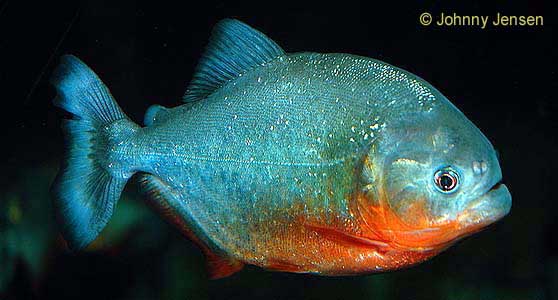
Red Bellied Piranha
The Red Bellied Piranha originates from the Amazon and Orinoco river basins in South America. Due to color variations and similar fish as far south as Argentina, this species is also known as the Gold Dust Piranha, the Ternetzi and the Yellow King Emperor Piranha. It was formerly known by the scientific name Serrasalmus nattereri. The Red Belly is the most common of all piranhas. It has very powerful, sharp teeth that continually replace.
Red Bellied Piranha - Reputation
The Red Bellied Piranha has a reputation for fierceness. The reputation started by a prank pulled on President Theodore Roosevelt while visiting Brazil. Red Bellied Piranha are actually fairly timid, nervous and inactive, except when hungry. They will play dead when frightened. The distinctive feature is the red belly, highlighted against a silver/grey body. Red Bellied Piranha are very similar in appearance to the Red Pacu, which is not a piranha. Piranhas grow very slowly.
Red Bellied Piranha - Feeding
When feeding, the Red Bellied Piranha is an aggressive meat eater that swarms on prey in large schools. They often nip fins and flesh without killing their prey. If they are hungry, they will attack your fingers. The tank should be about 100 gallons and should hold about 5 piranhas (2 gallons per inch of piranha). The tank should have driftwood and dim lighting. Soft, acidic water preferred. Live plants will likely be destroyed. A strong filter is recommended. The Red Bellied Piranha is strictly a meat eater. Care should be taken to ensure feeder fish are free of disease. Placing meat products in the aquarium will be appreciated by the piranhas, but will quickly foul the water.
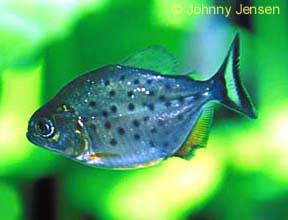
Juvenile Red Bellied
Red Bellied Piranha - Breeding
This species can be bred in captivity. Eggs are laid in plants in pits in the substrate. The male guards the eggs, which hatch in 2 - 3 days. Fry must be separated and fed live foods. Juveniles have black spots and lack the distinctive red color on the belly.
Red Bellied Piranha - Profile
-
Scientific Name: Pygocentrus nattereri
-
Family: Characin
-
Temperature: 23 -27 C; 73 - 81 F
-
pH: 5.5 - 7.5
-
Size: 30 cm; 12 inches
-
Life Span: 8 years
-
Breeding: Difficult, Egglayer
Red Bellied Piranha - Compatibility:
The Red Bellied Piranha is compatible with the Caribe Piranha, Pygocentrus piraya and other Red Bellied Piranhas.
Ternetzi Piranha
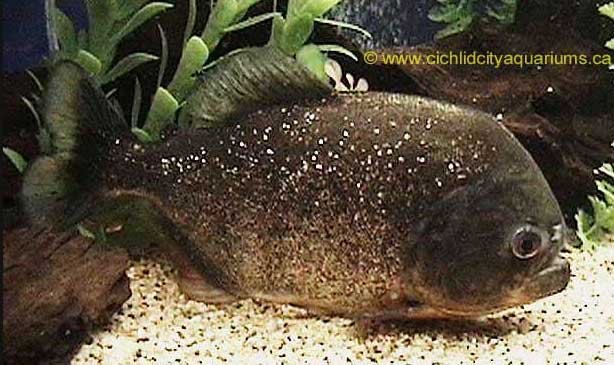
Ternetzi Piranha
The ternetzi piranha is yellow bodied and comes from Argentina. It's classification is still not finalized. It is considered a variant of the Red Bellied Piranha, but has not formally been recognized as a distinct species with the name Pygocentrus ternetzi. The Ternetzi Piranha is also referred to as the Gold Dust Piranha and the Yellow King Emperor Piranha. This piranha should be kept in a large aquarium of 40 or more gallons and prefers a group of at least 4 of its kind. This piranha will only eat meat, including any live freshwater feeder fish, frozen fish fillets, shrimp and other meat products. Extreme caution must be used, as it enjoys human fingers as a food source!
Ternetzi Piranha - Profile
-
Scientific Name: Pygocentrus ternetzi or Pygocentrus nattereri
-
Family: Characin
-
Temperature: 26 - 27 C; 78 - 81 F
-
pH: 6.8
-
Size: 30 cm; 12 inches
-
Life Span: 4 years
-
Breeding: Difficult, Egglayer
Ternetzi Piranha - Compatibility:
Black Piranha
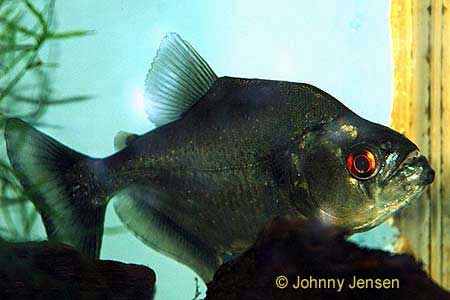
Black Piranha
The Black Piranha originates from the Amazon and Orinoco river basins in South America. It is also known as the Redeye Piranha, the White Piranha and the Spotted Piranha. The scientific name is serrasalmus rhombeus, but it is also referred to by the scientific name serrasalmus niger. The young are light colored with dark spots, which gives rise to the name White Piranha. As they mature, the dark spots disappear, the background color turns black and the eyes turn red. The anal fin has a red coloring and the edges of this fin are very dark when young. The young are more slender, while adults have the typical piranha shape. Black Piranha grow very slowly at 1 - 2 inches per year.
Black Piranha - Feeding
The Black Piranha does not swarm in large schools like the Red Bellied Piranha does. It can be rather timid, but its bite is still very dangerous. The tank should be about 100 gallons with bogwood and dim lighting. Soft, acidic water preferred. The Black Piranha is strictly a meat eater and should be kept alone. Care should be taken to ensure feeder fish are free of disease.
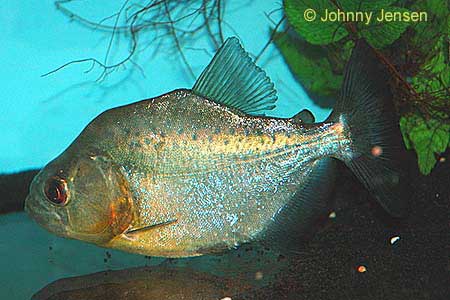
Black Piranha
Black Piranha - Breeding
Males are more golden, with red in the belly, while females are more yellow. This species can be bred in captivity. They are known to have survived in the wild in Hawaii and Florida. Eggs are laid in plants in pits in the substrate. The male guards the eggs, which hatch in 2 - 3 days. Fry must be separated and fed live foods.
Black Piranha - Profile
-
Scientific Name: Serrasalmus rhombeus
-
Family: Characin
-
Temperature: 23 - 27 C; 73 - 81 F
-
pH: 5.8 - 7.0
-
Size: 40 cm; 16 inches
-
Life Span: 4 years
-
Breeding: Difficult, Egglayer
Black Piranha - Compatibility:
The Black Piranha isn't really compatible with anything, not even other Black Piranhas.
Golden Piranha
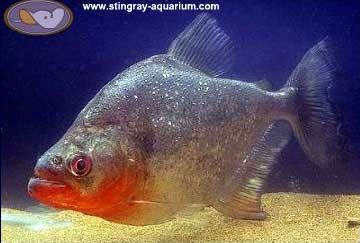
Golden Piranha
The Golden Piranha originates in the Amazon River. It is also known at the Yellow Piranha, the Black Diamond Piranha and Red-Throated Piranha. Some have yellow in their lower body, while others are red in this area. These two color variations are sometimes referred to as gold spilos and ruby red spilos. The distinctive features for both are a red throat, large speckled flakes on the flank and red in the eye. These piranha are not recommended for the inexperienced, as these are dangerous meat eaters.
Golden Piranha are fin nippers and will even attack their own kind. They should be kept alone, as they establish isolated territories. They are one of the few species of piranha that have been bred in captivity.
Golden Piranha - Profile
-
Scientific Name: Serrasalmus spilopleura
-
Family: Characin
-
Temperature: 23 - 28 C; 73 - 82 F
-
pH: 5 - 7
-
Size: 20 cm; 8 inches
-
Life Span: years
-
Breeding: Difficult, Egglayer
Golden Piranha - Compatibility:
Pike Piranha
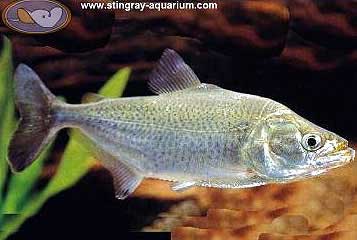
Pike Piranha
Caribe Piranha
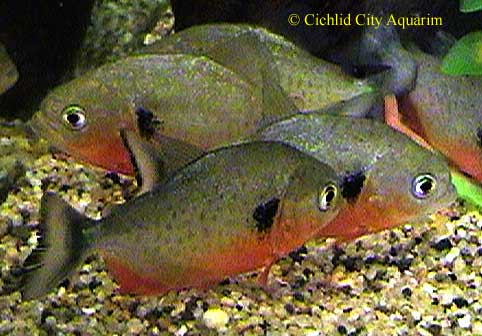
Caribe Piranha
Violet Piranha
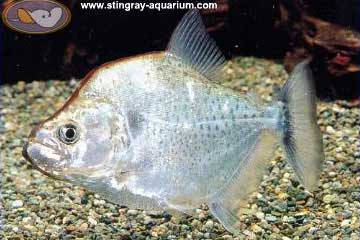
Violet Piranha